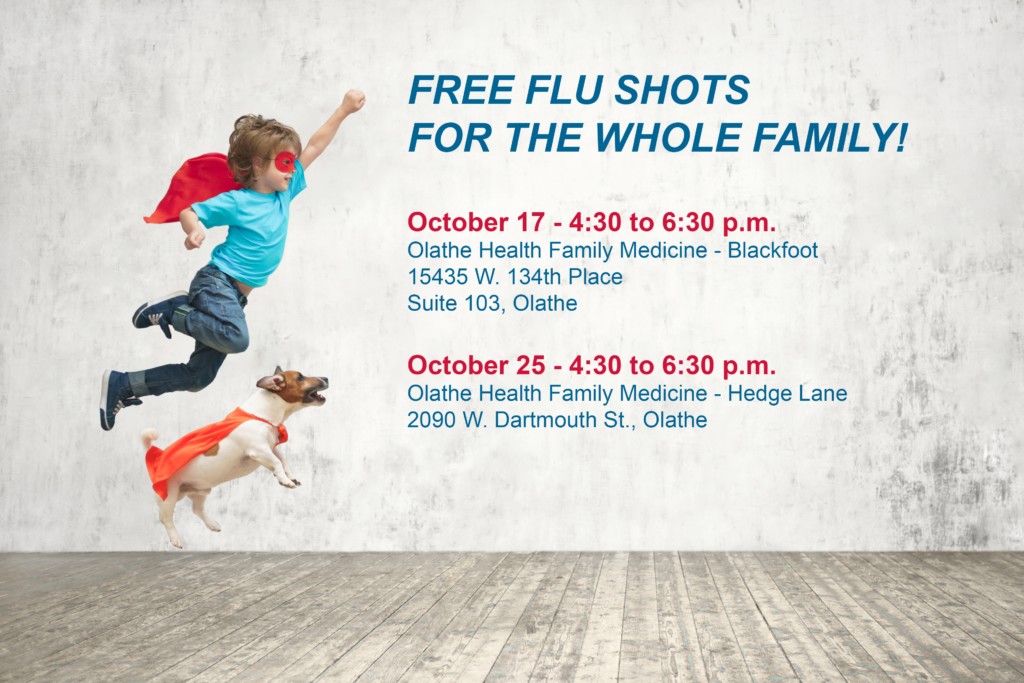It’s beginning to look a lot like FLU SEASON! Olathe Health Pediatrician Elizabeth Musil, MD, answers some more frequently asked questions and offers her advice on how to get through the flu season.
I’m sure you are as excited as we are about this season. It’s also that time of year when flu shots become available – YAY! Now, I’ll be honest with you – I didn’t start getting flu shots until I was required to in medical school; however, after doing the research and personally witnessing otherwise very healthy kids and adults get incredibly sick from the flu, it’s something I won’t go without again. The American Academy of Pediatrics recommends that everyone six months of age and older get a flu shot for the 2018-2019 season as soon as it is available (which is now!).
The flu is dangerous – much more dangerous than the common cold. It can lead to hospitalization, ICU admission or even death. In the 2017-2018 flu season, more than 180 kids died. This is the highest number of kids dying from the flu since the CDC started tracking flu-related deaths in 2004. And of the ones that died? 80% were not vaccinated against the flu.
OK so what is the flu exactly? What is the difference between a cold and the flu?
Influenza (the flu) is a contagious respiratory illness caused by influenza viruses. Colds are also caused by viruses, just different ones that specifically cause the flu. The only way to tell if you have the flu is to do special testing at your doctor’s office (nasal swab). Since both types of illness are caused by viruses, antibiotics won’t help!
How does the flu spread?
The flu spreads through droplets – sneezing, coughing, blowing your nose – and can stay on surfaces for a period of time. So if someone with the flu touches a surface and you touch it a short time after them, you could get it. That’s why handwashing and covering your/your child’s mouth when you/they sneeze or cough is so important.
What are symptoms of the flu?
Many symptoms of the flu are similar to other viruses. You can have fever, chills, sore throat, cough, runny/stuffy nose, headache, stomachache and body aches. The flu is more of a respiratory virus, not so much a vomiting/diarrhea one. Symptoms can last for up to a week. You can also get complications from the flu, such as pneumonia, sinus infections, ear infections, and even blood infections.
My child was tested and has the flu. What now?!
The most important thing you can do is keep them comfortable and hydrated. If they don’t want to eat, that’s okay – most of us don’t want to eat when we’re sick. But it is important to stay hydrated. Be sure to push fluids – water, drinks with electrolytes, etc. You can also try things like popsicles (Pedialyte even makes some popsicles) or applesauce. With kids two years and older, ensure they’re peeing at least three times in 24 hours. In kids who are two years and younger, ensure they’re peeing at least four times in 24 hours. There is a medication called Tamiflu that can sometimes help shorten the duration of symptoms, depending on when it is started. This is something you should talk with your doctor about.
Tell me more about Tamiflu. What are the side effects?
Tamiflu is an anti-viral medication that can sometimes help shorten the duration of symptoms, depending on when it is started in the course of the illness. It tends to work best when started within the first 48 hours of symptom onset. There are liquid and capsule forms. Sometimes, pharmacies run out of the liquid form so we will send capsules you can open and sprinkle on applesauce or pudding for kids to take. This medicine is not appropriate for everyone, which is why your doctor needs to help decide if it will benefit your child. Just like any medication, there are potential side effects, the most common being headache, fussiness, nausea/vomiting/upset stomach. Sometimes, kids will complain of hallucinations as well, in which case we stop the medication.
When can my child return to school/daycare after having the flu?
Typically your child can return to school or daycare when they have been fever free for 24 hours and symptoms are improving.
Why do we have to get a flu shot every season?
The flu viruses are smart and are constantly changing to get around our defenses and make us sick. The CDC works year round collecting data to figure out which strains of flu will be most prevalent year to year. So, unlike childhood immunizations that generally stay the same each year, the flu vaccine works to provide the most up-to-date protection for that specific season.
I heard the flu shot doesn’t really work. So why should I get it?
There are lots of misconceptions about the flu shot. Is it 100% effective at preventing the flu? No. Scientists do their best to create a vaccine each year based on the research they’ve done on the previous year’s flu strains. Although effectiveness does vary from year to year, the CDC estimates the flu vaccine reduces your risk of getting the flu by 40-60% when the vaccine is well matched to circulating viruses.
A bigger point is that the flu vaccine has been shown to significantly reduce the risk of death in children. A study published in Pediatrics in 2017 showed that between 2010 and 2014, the flu vaccine reduced the risk of flu-related death by 51% (half!) among children with other high-risk medical conditions. It also reduced the risk of death in healthy children by 65%!
It’s also important to note that if you get the flu shot and still end up getting the flu, symptoms will last for a shorter period of time and will not be as severe. You also have a lower risk of flu-related complications (like hospitalization, pneumonia, blood infections, etc).
Which kids have to get two doses of the flu shot and why?
If it’s your child’s first flu season receiving the vaccine and they are nine years old or younger, they will receive two doses of the vaccine four weeks apart. This helps prime their immune system. The first shot shows their body what the flu viruses looks like and the second shot is a reminder to make even more protective antibodies (memory germ-fighting cells). Once they get two doses of the flu shot their first season, they only need one dose each season after that.
My baby is under six months old. How can I protect them from getting sick?
The best things you can do is have everyone else in the house (or who will be around your baby) vaccinated and practice good handwashing. If you have older kids in the house, teach them about handwashing, sneezing/coughing into their arm, and avoid kissing the baby if they are sick.
My child is healthy. Do they still need the flu shot?
Unfortunately, every year there are healthy kids and adults who die from influenza. Getting a flu shot reduces the risk of your child being hospitalized as a result of the flu or its complications. Additionally, it protects those around them – older adults who have weakened immune systems, people with cancer, and babies who are too young to be vaccinated. Remember, studies showed getting the flu shot reduced the risk of death in healthy kids by 65%!
I get sick every time I get the flu shot. Why should I get it?
You cannot get the flu from the flu shot – the influenza virus in the flu shot is inactive (killed).
If you feel crummy after you get a shot, that can be a good thing! It means your immune system is up and running, working to create antibodies to protect you in the future. When you get a shot, it triggers an inflammatory response in your body, a very similar type of response that is triggered when you get an infection. It’s the same reason kids sometimes get a fever after their childhood immunizations – their immune system is getting to work! So sometimes you may feel feverish or achy after getting a shot, but it’s a small price to pay for how sick you could get the flu. The most common complaint we hear after giving a flu shot is some soreness around the area where the shot was given.
Just to be clear: You cannot get the flu from the flu shot!
I heard the flu nasal spray is back this year. Can we do that instead of the flu shot?
Short answer: Yes – as long as your child doesn’t have a history of asthma/wheezing/respiratory problems and is two years or older.
Long answer: We’d still rather give the shot. Although they revamped the FluMist vaccine, we still don’t know how effective it will be this year. It was taken off the market in 2017 when it was not as effective against a few of the flu strains. The actual shot, however, has been proven to be most effective in protecting against all strains of the flu the last few years.
If you have more questions, please talk to your child’s pediatrician. Remember, it takes about two weeks for your body to build up an antibody response, so the earlier you get the vaccine, the better!
Get vaccinated!

















